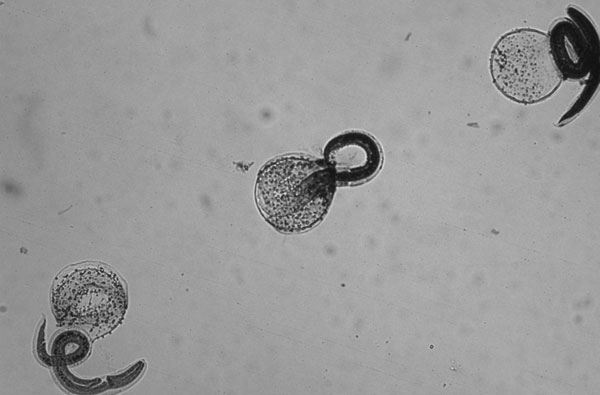Baylisascaris infection laboratory findings: Difference between revisions
| Line 15: | Line 15: | ||
===Microscopy=== | ===Microscopy=== | ||
[[Image:Baylisascaris larvae.jpg| | [[Image:Baylisascaris larvae.jpg|center|thumb|500px|Baylisascaris procyonis larvae]] | ||
[[Image:Unembryonated eggs of Baylisascaris procyonis.jpg|center|Unembryonated eggs of Baylisascaris procyonis]] | [[Image:Unembryonated eggs of Baylisascaris procyonis.jpg|center|Unembryonated eggs of Baylisascaris procyonis]] | ||
'''A:''' Unembryonated eggs of Baylisascaris procyonis. These eggs are thick-shelled and usually a little oval in shape. Size of these eggs is 80-85 microns by 65-70 microns. The eggs of B. procyonis have a similar morphological appearance as fertile eggs of Ascaris lumbricoides with size (A. lumbricoides eggs being 55 to 75 microns by 35 to 50 microns) as the most evident distinguishing characteristic. Unembryonated eggs of B. procyonis are passed only in the feces of raccoons and skunks (and sometimes other carnivorous animals) onto the soil, after which they further develop to the infective second stage larva in about 2 to 3 weeks. Humans become infected by accidentally ingesting infective eggs from soil, water, hands, food or other objects contaminated with raccoon or skunk feces. As in Toxocara infections, eggs are not a diagnostic finding since they are not excreted in human feces. | '''A:''' Unembryonated eggs of Baylisascaris procyonis. These eggs are thick-shelled and usually a little oval in shape. Size of these eggs is 80-85 microns by 65-70 microns. The eggs of B. procyonis have a similar morphological appearance as fertile eggs of Ascaris lumbricoides with size (A. lumbricoides eggs being 55 to 75 microns by 35 to 50 microns) as the most evident distinguishing characteristic. Unembryonated eggs of B. procyonis are passed only in the feces of raccoons and skunks (and sometimes other carnivorous animals) onto the soil, after which they further develop to the infective second stage larva in about 2 to 3 weeks. Humans become infected by accidentally ingesting infective eggs from soil, water, hands, food or other objects contaminated with raccoon or skunk feces. As in Toxocara infections, eggs are not a diagnostic finding since they are not excreted in human feces. | ||
Latest revision as of 17:20, 26 November 2012
|
Baylisascaris infection Microchapters |
|
Diagnosis |
|---|
|
Treatment |
|
Case Studies |
|
Baylisascaris infection laboratory findings On the Web |
|
American Roentgen Ray Society Images of Baylisascaris infection laboratory findings |
|
Risk calculators and risk factors for Baylisascaris infection laboratory findings |
Editor-In-Chief: C. Michael Gibson, M.S., M.D. [1]
Overview
Baylisascaris infection is difficult to diagnose and often is made by ruling out other infections that cause similar symptoms.
Laboratory Findings
- Results from complete blood count (CBC) and cerebrospinal fluid (CSF) examination would be consistent with parasitic infection, but tend to be nonspecific.
- Examination of tissue biopsies can be extremely helpful if a section of larva is contained, but removing an appropriate piece of tissue where the larva is actually present can be problematic.
- Ocular examinations revealing a migrating larva, larval tracks, or lesions consistent with a nematode larva are often the most significant clue to infection with Baylisascaris.
- Serologic testing can be extremely helpful in suspected cases; however, tests are not routinely in use nor widely available.
Microscopy


A: Unembryonated eggs of Baylisascaris procyonis. These eggs are thick-shelled and usually a little oval in shape. Size of these eggs is 80-85 microns by 65-70 microns. The eggs of B. procyonis have a similar morphological appearance as fertile eggs of Ascaris lumbricoides with size (A. lumbricoides eggs being 55 to 75 microns by 35 to 50 microns) as the most evident distinguishing characteristic. Unembryonated eggs of B. procyonis are passed only in the feces of raccoons and skunks (and sometimes other carnivorous animals) onto the soil, after which they further develop to the infective second stage larva in about 2 to 3 weeks. Humans become infected by accidentally ingesting infective eggs from soil, water, hands, food or other objects contaminated with raccoon or skunk feces. As in Toxocara infections, eggs are not a diagnostic finding since they are not excreted in human feces.